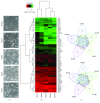Laminin 521 Stabilizes the Pluripotency Expression Pattern of Human Embryonic Stem Cells Initially Derived on Feeder Cells
- PMID: 29535778
- PMCID: PMC5835285
- DOI: 10.1155/2018/7127042
Laminin 521 Stabilizes the Pluripotency Expression Pattern of Human Embryonic Stem Cells Initially Derived on Feeder Cells
Abstract
Human embryonic stem (hES) cells represent an important tool to study early cell development. The previously described use of human recombinant laminin (LN) 521 represented a step forward in generating clinically safe culture conditions. To test the short-term effect of LN521 on cultured hES cells, five male hES cell lines were cultured on human foreskin fibroblasts (hFFs), Matrigel, LN521, and LN121 and characterized by qPCR, immunofluorescence analysis, as well as their potential for three-germ layer differentiation. Variations in gene expression related to pluripotency, stemness, and testicular cells at different passages and culture conditions were evaluated by qPCR. All cell lines expressed pluripotency markers at protein and RNA level and were able to differentiate into cell types of the three germ layers after being cultured on LN521 for nine passages. Reduction in variation of pluripotency marker expression could be observed after culturing the cells on LN521 for nine passages. hES cells cultured on LN521 exhibited less differentiation, faster cell growth, and attachment when compared to hES cells cultured on LN121 or Matrigel. Our results indicate a positive effect of LN521 in stabilizing pluripotency gene expression and might be the first step towards more controllable and robust culture conditions for hES cells.
Figures



References
LinkOut - more resources
Full Text Sources
Other Literature Sources

